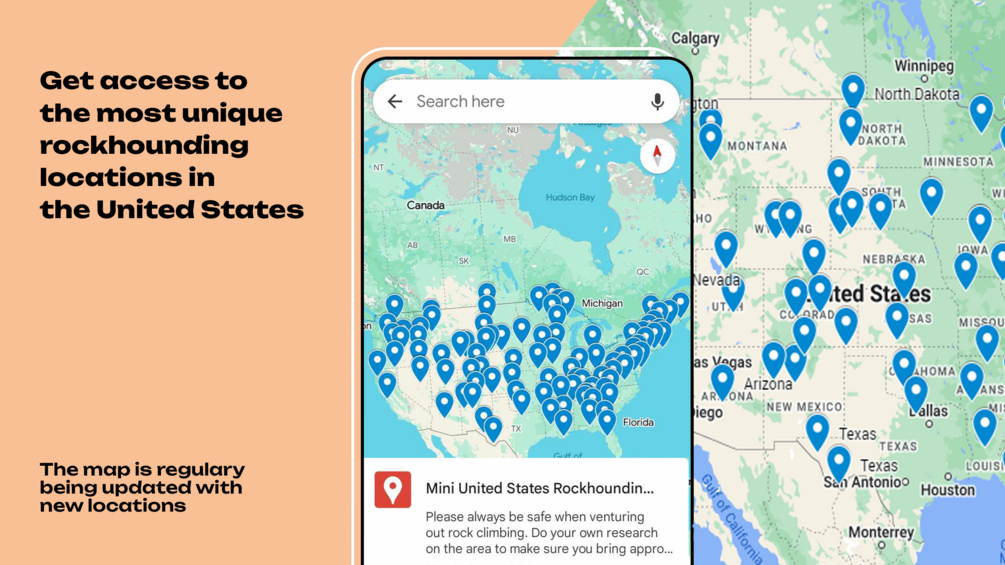Tennessee’s diverse geology isn’t just a treat for the eyes; it’s a playground for rockhounding enthusiasts like you.
From the Mississippi River plains to the Great Smoky Mountains, the Volunteer State is teeming with hidden geological treasures waiting to be uncovered.
Whether you’re a seasoned rockhound or a curious newbie, you’ll find a variety of sites to explore. You’re in for a real adventure as you dig for sparkling quartz, uncover ancient fossils, or even stumble upon the state’s prized Tennessee Paint Rock agate. Ready to discover what lies beneath the surface?
Let’s get started on your Tennessee rockhounding journey.
Tennessee offers a rich array of rockhounding sites, each unique in its geological offerings. Key locations include the Central Basin for quartz crystals, the Cumberland Plateau for Paint Rock agate, Elmwood Mine for calcite and fluorite, and Cherokee Mine for amethysts and garnets.
Get our FREE United States Rockhounding Map HERE

Tennessee Rockhounding Locations
When embarking on your rockhounding adventure in Tennessee, you’ll find no shortage of spots brimming with geological treasures. Each location offers a unique blend of minerals and gems native to the area, providing an exciting challenge for both novice and experienced collectors.
Central Basin is your go-to for sparkly quartz crystals. Here, the hidden geodes are ripe for the picking, nestled within limestone deposits. The thrill of cracking open a geode to reveal its crystal-lined cavity is unmatched and sure to keep you coming back.
Moving on, the Cumberland Plateau presents the perfect opportunity to hunt the esteemed Tennessee Paint Rock agate. These agates, known for their intricate patterns and vibrant colors, stand out as a collector’s favorite. It’s a hands-on experience that connects you with the ancient, volcanic history of the region.
Elmwood Mine, near Carthage, is another must-visit location for serious rockhounds. Renowned for its world-class crystals of calcite, fluorite, and barite, the mine allows rock enthusiasts to explore designated areas. Remember to bring your gear as this site offers a true digging experience where you can unearth specimens directly from the source.
In eastern Tennessee, the Cherokee Mine is a hotspot for uncovering a wide variety of minerals. Not only will you find gorgeous amethysts and garnets, but also phosphate minerals like wavellite, which is a real treat for collectors due to its rarity and unique appearance.
Below is a quick reference guide to these enticing locations:
| Location | Minerals and Gems to Find |
|---|---|
| Central Basin | Quartz Crystals, Geodes |
| Cumberland Plateau | Tennessee Paint Rock Agate |
| Elmwood Mine | Calcite, Fluorite, Barite |
| Cherokee Mine | Amethysts, Garnets, Phosphate Minerals (e.g. wavellite) |
Embarking on a rockhounding journey through Tennessee not only rewards you with remarkable specimens but also immerses you in the natural beauty and geological history unique to each location. Remember to always seek permission where necessary and adhere to local collecting rules to preserve these sites for future generations of rockhounds.
What Gemstones are Found in Tennessee?

Tennessee’s diverse geological landscape is a treasure trove for gemstone enthusiasts. Your quest for precious gems could be rewarded with a variety of stones, each with its unique allure. One of the most coveted of these gems is the Tennessee River Pearl. These pearls aren’t your traditional ocean finds; they’re sourced from freshwater mussels inhabiting the state’s rivers and are recognized for their lustrous beauty.
As you traverse the streams of Tennessee, keep an eye out for sapphires. While these are typically associated with Montana, they also surface here, bringing their blue hues to your collection. Equally striking, the iridescent sheen of freshwater pearls from the state’s rivers adds another level of excitement to your hunt.
Don’t miss out on Tennessee’s agates, especially the notable Tennessee Paint Rock agate, which makes a vivid addition to any rockhound’s assortment with its deep, intricate patterns and colors ranging from reds to yellows.
- Pearls – freshwater, from the Tennessee River
- Sapphires – occasionally found in streams
- Tennessee Paint Rock Agate – uniquely patterned and colorful
For those intrigued by Tennessee’s mineral riches, searching for uncommon gemstones such as crinoid fossils and geodes could prove fruitful. Crinoids, with their star-shaped patterns, and the hollow, crystal-lined geodes, remind us of the primordial seas that once covered this land.
| Gemstone | Description |
|---|---|
| Tennessee Pearls | Lustrous, often from freshwater mussels |
| Sapphires | Blue-hued, found in some streams |
| Tennessee Agates | Red to yellow patterns, highly collectible |
| Crinoid Fossils | Star-shaped patterns from ancient marine life |
| Geodes | Hollow rocks lined with crystals |
Embark on your journey across Tennessee and be part of the age-old tradition of discovering and appreciating nature’s buried treasures. And remember, while uncovering these natural wonders, to sustainably enjoy rockhounding, respecting the legalities and guidelines that keep this hobby thriving for all.
What Sedimentary Rocks You Can Find in Tennessee?

Sedimentary rocks are a rockhound’s dream, and Tennessee doesn’t disappoint with its diverse range. Unearthing these rocks can transport you millions of years back, providing a tangible connection to the ancient environments that once existed here.
In the eastern parts of Tennessee, limestone is prevalent. It forms from marine organisms’ skeletal fragments, like coral and foraminifera, which accumulate on the ocean floor. Over time, layers build up and create limestone beds. Limestone can be easily recognized by its typically light color and is often used in construction.
Shale, another sedimentary rock, is also common in Tennessee. This finely-layered rock forms from compacted mud and silt, often found along the banks of rivers and streams. It’s usually gray but can exhibit other hues depending on its mineral content. Shale is the source rock for most of the oil and gas deposits we use today.
Sandstone is another sedimentary treasure you may encounter. It consists of sand grains cemented together, often containing quartz. Look for sandstone in various colors ranging from white to red, each indicating different conditions during its formation.
For collectors keen on finding coal, the Cumberland Plateau has historically been a significant coal-producing area. Coal forms from plant debris subjected to intense heat and pressure over millions of years. Though not as glamorous as gemstones, coal’s importance in fueling the industrial revolution cements its place in any serious rock collection.
It’s worth noting that rock quality may vary, and factors such as weathering and natural erosion can affect your finds. When hunting for these sedimentary rocks, you may also stumble upon fossils, which serve as bookmarks in the history of life on Earth. Always remember to check local guidelines before heading out on your rockhounding adventure.
What Metamorphic Rocks are found in Tennessee?
Tennessee’s geologic diversity includes an impressive array of metamorphic rocks, which are transformed from pre-existing rock types through heat, pressure, and chemical processes. Gneiss, characterized by its banded appearance, can be found, particularly in the eastern parts of the state, like the Appalachians. This high-grade metamorphic rock often shows distinct foliation and layering caused by the extreme conditions it was subjected to.
Another notable metamorphic rock you’ll encounter in Tennessee is schist. With its glittery layers caused by the abundance of mica, schist can be quite a find for any rockhound. The origins of schist in the state trace back to the intense alteration of shale and mudstone.
The presence of slate in Tennessee is a testament to the state’s dynamic geological past. Slate, stemming from shale under low-grade metamorphism, is often sought after for its use in construction and as a decorative stone. It’s worth noting that these metamorphic rocks are often found near mountainous regions or areas with a history of tectonic activity.
In addition to gneiss, schist, and slate, Tennessee is home to marble, specifically the coveted Tennessee Pink Marble. This isn’t true marble but rather a crystalline limestone that’s been metamorphosed. Displaying a pinkish hue and a fine-to-medium grain, it has been used in many historical buildings and is still prized today.
Rockhounding in Tennessee for metamorphic rocks can be an exciting adventure as each find tells a story of Earth’s transformative power. Remember to always check land ownership and obtain permission before collecting on private property or in protected areas.
When planning your trip, be sure to consider the following locations known for their metamorphic treasures:
- Great Smoky Mountains
- Cumberland Plateau
- Chattanooga region
Gear up with the right tools, establish the appropriate permissions and get ready to uncover the metamorphic secrets of Tennessee’s landscapes.
What Igneous Rocks can You Find in Tennessee?
Tennessee’s geological diversity includes a range of igneous rocks, though they are less commonly found than sedimentary and metamorphic types in the state. As you explore, you might come across basalt and diorite, two igneous rocks formed from cooled lava and magma respectively.
Basalt is typically fine-grained and dark in color, owing to its rapid cooling on the surface after a volcanic eruption. In Tennessee, basalt can sometimes be found in small amounts in the eastern part of the state where ancient volcanic activity once occurred. Unlike sediments that gently settle into layers, basalt bursts forth from the Earth, cooling quickly and locking in minerals like calcium-rich plagioclase feldspar, pyroxene, olivine, and iron oxides.
Diorite, on the other hand, emerges from a deeper story. It crystallizes slowly beneath the Earth’s surface, leading to a coarser texture than basalt. With a composition that’s intermediate between granite and basalt, diorite composes a portion of the state’s underground features. It contains a mix of white plagioclase feldspar, hornblende, biotite, and sometimes pyroxene.
If you’re specifically seeking igneous rocks in Tennessee, certain quarries and old mining sites near the Appalachian Mountains may yield these treasures. Here’s where you’d typically find them:
- Eastern Regions: Near the ancient volcanic sites.
- Quarries: Abandoned or active sites might have exposed sections of igneous rock.
When hunting for rocks, always ensure you have the correct permissions to collect. Many of these sites are on private property or may have specific regulations regarding rock collection. By respecting these boundaries, you’ll not only stay within the law but also help preserve the geological heritage of Tennessee for future generations of rockhounds.
Panning for Gold in Tennessee
Gold panning in Tennessee, although not as renowned as in the Western states, can still yield gratifying results for those with a keen eye and patience. Public lands along the creeks in the Appalachian region of eastern Tennessee are your best shot for discovery. The areas around Coker Creek and the Little River have a historical record of gold finds and remain popular among enthusiasts today.
When setting out for a day of gold panning, remember to equip yourself with the essentials: a pan, a sieve, and a sense of adventure. Start with lighter sand and gravel, swirling water in your pan to separate gold from other materials. Gold, being denser, will settle at the bottom. Patience is key here. You’ll often find gold particles, known as “flour gold”, in Tennessee streams.
Key Locations for Panning:
- Coker Creek: Well-known for its gold deposits
- Little River: Another hot spot, especially after heavy rainfall
- Look for areas where heavy stones gather; gold might be nearby.
- Practice the swirl; it’s the panner’s essential skill.
In Tennessee, the areas you can pan are mostly on public lands, but don’t assume all areas are open for panning. Laws and regulations are strict to preserve the environment. Always check local regulations before you start. In some places, permits might be necessary.
If you’re new to the game or want to learn from seasoned pros, consider joining a local rockhounding or gold panning group. Such communities are often the best resource for tips, locations, and the latest on legal requirements. Besides, it’s a great way to gain camaraderie in your quest for treasure.
Remember, finding gold requires diligence, respect for the land, and a little bit of luck. As you sift through the waters of Tennessee’s streams, you might just come across that glint of yellow that turns an ordinary day into one of the most exhilarating experiences of your rockhounding adventures.
Rocks and Minerals Found in Tennessee
Tennessee’s landscape is a treasure trove for rockhounds like you, bursting with a variety of minerals and rocks, each with their own unique attributes and history. Calcite, found predominantly in the state, is easily recognizable by its clear to white color and its perfect three-way cleavage. It’s not just a collector’s favorite; it also serves practical purposes in the making of cement and lime.
Another gem you’ll come across is fluorite, which mesmerizes with a range of colors, from purple to green, depending on the impurities it contains. It’s not just beautiful; it’s also useful in the manufacturing of steel and aluminum.
Barite is yet another mineral that’s abundant in certain regions of Tennessee, known for its high specific gravity and range of colors. This mineral isn’t just a collectible. With its diverse applications in drilling fluids and medical science, barite bridges the gap between the beauty of gem collecting and the pragmatism of industrial use.
For those fascinated by the historic aspect, you’ll be thrilled to find Mississippian epoch fossils, shedding light on the marine life that once thrived millions of years ago. You’ll find these mostly imprinted in limestone.
Don’t overlook the sediments! You might stumble upon quartz, the second most abundant mineral in the Earth’s crust. With its hardness and resilience, quartz not only makes for an enduring collectible but has also been integrated into the technology industry, pushing the boundaries of innovation.
You’ll also encounter a variety of geodes in Tennessee, spherical rocks with crystalline structures inside. These geological formations, formed by the deposition of minerals over time, are like natural surprise packages, with each one revealing a unique pattern and coloration when cracked open.
While Tennessee may not be the Wild West of rockhounding, it offers its own unique brand of adventure. Keep your eyes peeled, your permissions in order, and your gear ready for an unforgettable rockhounding experience.
Where Can I Find Fossils in Tennessee?
Tennessee offers a plethora of sites where you can unearth fossils, a testament to the state’s rich prehistoric life. The best areas are often along creeks, riverbeds, and quarries where sedimentary rocks are exposed. Due to the state’s geological history, the fossils you find here often date back to the Paleozoic era.
Coon Creek Formation, located in McNairy County, is one of the most noteworthy areas. As a treasure trove of fossil specimens, the site is managed for scientific study, and access may be limited, so check site regulations before you visit. The fossils found here are typically marine organisms like mollusks and trilobites that thrived in the shallow seas that once covered the region.
Another notable location is The Gray Fossil Site near East Tennessee State University. The site is remarkably more recent than other sites, dating back only a few million years. Here, you might spot fossils from the Miocene epoch, such as those of ancient tapirs, red pandas, and mastodons.
In Davidson County, along certain portions of the Harpeth River, you have the chance to find fossils from the Ordovician period. These areas are rich in brachiopods, bryozoans, and crinoid stems that lived in the ocean over 450 million years ago.
Before you go hunting for fossils, be sure to familiarize yourself with Tennessee’s laws regarding fossil collection. Some sites are protected and prohibit the removal of specimens, while others allow limited collecting for personal use. Remember that it’s essential to respect these regulations to preserve the sites for educational and scientific purposes.
Here’s a quick checklist before your fossil hunting trip:
- Secure permission if you’re entering private land or protected areas
- Bring the right tools, like a geologist’s hammer and eye protection
- Wear appropriate clothing and footwear for potentially rough terrain
- Stay mindful of local wildlife and plants
Tennessee’s diverse range of fossil sites guarantees a rewarding search for prehistoric treasures buried within its grounds. With each discovery, you’re not just picking up a piece of rock; you’re holding a fragment of Earth’s ancient history in your hands. Keep exploring, and each site will reveal its unique story, piece by piece.
Tennessee Rockhounding Laws & Regulations
Before you set out on your rockhounding adventure in Tennessee, it’s crucial to be aware of the state laws and regulations governing the collection of rocks, minerals, and fossils. Adhering to these guidelines ensures that you’re not only respecting the environment but also staying on the right side of the law.
Private Land Access
If you’re planning to rockhound on private property, you must obtain permission from the landowner beforehand. Exploring without consent is considered trespassing, and you could face serious legal repercussions. Always respect property boundaries and leave gates or fences as you find them.
Public Lands and Waterways
On public lands, such as state parks or national forests, rockhounding activities may be allowed, but there are often limitations. You’re usually permitted to collect small amounts of common invertebrate fossils like brachiopods and trilobite fragments, provided they’re for personal use and not for sale. However, the collection of vertebrate fossils is typically prohibited without a scientific permit.
- State Parks: Often restrict the removal of any natural resources. Check park rules before collecting.
- National Forests: May allow limited collection for non-commercial purposes, but a permit might be required.
- Waterways: Collecting in or near water bodies can be subject to additional regulations to protect aquatic ecosystems.
Tennessee Fossil Collection Laws
Fossils hold significant paleontological value and are often subject to stricter rules than rocks and minerals. Tennessee law stipulates that vertebrate fossils cannot be collected without explicit permission from the landowner and oftentimes a state-issued permit. Invertebrate and plant fossils are generally more accessible but are still subject to site-specific regulations.
Cave Protection
Caves in Tennessee are protected under the Tennessee Cave Protection Act. Disturbing cave formations, including speleothems—stalactites and stalagmites—is illegal. Additionally, removing any materials from a cave without a permit is a punishable offense. Rockhounds should always avoid cave systems unless they have the proper authorization.
By familiarizing yourself with these laws and regulations, you can ensure a lawful and ethical rockhounding experience in Tennessee. Stay informed of any regional or local changes to these regulations to enjoy your hobby without adversely impacting the state’s natural and cultural heritage.
Rockhounding Tips for Beginners in Tennessee
Gearing Up: Essential Tools for Rockhounding
Before venturing out on your first rockhounding excursion in Tennessee, you need to gear up properly. The right tools can make a significant difference in your experience and success:
- Rock Hammer: A sturdy rock hammer is invaluable for chipping away at rock faces and breaking open geodes.
- Chisels and Picks: Invest in a set of chisels and picks of various sizes for extracting specimens.
- Safety Goggles: Protect your eyes from chips and dust with a pair of safety goggles.
- Gloves: Durable gloves will safeguard your hands against sharp rocks and rough terrain.
Additionally, consider packing a backpack with a first-aid kit, a GPS or map for navigation, and extra water and snacks to stay energized.
Safety Tips While Rockhounding
Your safety is paramount while rockhounding. Always inform someone of your planned location and return time. Here’s how you can stay safe out in the field:
- Stay Aware of Your Surroundings: Keep an eye out for potential hazards like snakes, uneven ground, and loose rocks.
- Wear Appropriate Clothing: Dress in layers and wear sturdy boots with ankle support.
- Hydrate and Apply Sunscreen: Dehydration and sunburn can sneak up on you, so drink plenty of water and apply sunscreen regularly.
By respecting the natural environment and prioritizing safety, you’ll ensure your rockhounding adventures are not just fruitful but also enjoyable.
Legal Guidelines for Rockhounding Enthusiasts
Understanding Tennessee’s legal landscape is crucial for rockhounding enthusiasts. Adhere to the following to stay within legal boundaries:
- Seek Permission: Always obtain permission before collecting on private property.
- Collect Responsibly: Avoid over-collecting and leave no trace of your activities.
- Familiarize With Regulations: State and federal lands have specific rules regarding the collection of rocks and minerals. Ensure you’re aware of them to avoid fines or legal issues.
Remember, respecting property rights and environmental regulations is not only ethical but also helps preserve rockhounding opportunities for everyone.
Conclusion: Tennessee Rockhounding Guide & Map
Tennessee’s diverse geological landscape offers you a treasure trove of opportunities for rockhounding.
Whether you’re searching for the luster of quartz or the intrigue of ancient fossils, you’re bound to uncover something that piques your interest. Remember, your adventure requires more than just enthusiasm. It’s essential to respect the land and adhere to the regulations set forth to ensure that rockhounding remains a sustainable hobby for everyone. Equip yourself with the right tools and knowledge, and you’re all set for an unforgettable experience. So grab your gear, follow the guidelines, and get ready to explore the natural wonders that lie beneath Tennessee’s soil.
Happy rockhounding!




![Alabama Rockhounding Sites in [year]: Fossil & Mineral Spots](https://observationhobbies.com/wp-content/uploads/2024/01/SHOqOO3B-QS16Lqks0Ax9-768x439.jpg)


